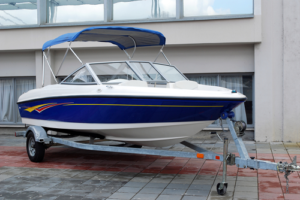Boat lettering and boat decals don’t seem to get as much press as they deserve, and that’s a shame because both can spruce up your voyage on the high seas.
If you’re living in California, then you might want to listen up since you might actually be legally required to have your identification info and hailing port designation in the right spots.
Difference Between Boat Lettering and Boat Decals
Boat lettering and boat decals serve slightly different purposes and are manufactured in different way, so let’s take a look at that.
First off, the name of your boat, registration number of your boat, as well as the hailing port designation for your vessel should probably be done with boat lettering.
Your boat lettering will be independently cut out of a solid piece of vinyl material each time. The material won’t have any print on it but it will be highly durable and constructed out of a solid-colored sheet of vinyl.
International Waters? No Rules? Not Quite…
 There are both local and state ordinances vis-a-vis height and placement of registration information and hailing port designation information.
There are both local and state ordinances vis-a-vis height and placement of registration information and hailing port designation information.
The same goes for rules about placement, separating certain characters with hyphens, and having a stark contrast with the color of your vessel and boat lettering.
Another interesting aspect of boat lettering is that the style and size of the letters might be regulated locally in Santa Rosa, California and nearby areas.
For instance, you might need to use legible block letters, as opposed to serif fonts that are overly flowery and difficult to decipher from a distance (or even close up!), and have each letter no less than a certain height from top to bottom.
How tall? Around three inches tends to be the minimum for boat registration information and hailing port identification information. Check with the city of Santa Rosa to make sure you have the right size and you don’t find yourself adrift!
Boat Decals Open Many Creative Doors
Boat decals, like car decals, can handle hundreds of different designs, complex gradients, and text effects.
Because boat decals are constructed from a single piece of material, unlike boat lettering, there’s no need for premasking and boat decals can be printed directly onto the vinyl.
Boat decals are applied with the peel-and-stick method that you might remember from way back in gradeschool.
Boat lettering, on the other hand, is applied with the use of transfer tape, and you can find out more about the process here.
Expect Years of Reliable Service
For all of the differences between boat lettering and boat decals, you’ll appreciate the fact that both are incredibly durable against the elements, as long as they’re not submerged in the water for years on end.
Under normal conditions, boat lettering and boat decals can withstand a huge range of temperatures – if installed properly, your new boat lettering and boat decals should be fine between about minus 50 degrees and slightly over 200 degrees fahrenheit.
You would think that these numbers would be describing temperatures on Mars!
In fact, your boat lettering and boat decals should last well over five years when applied correctly and provide years on reliable service on the high seas thanks to UV resistant materials and UV ink designed to remain vibrant for potentially a decade or more.
Where Does Boat Lettering Go?
Most areas require you to have your boat’s hailing port identification information on the stern (back) of your boat and the registration number nearer the bow (front) and flying high above the waterline.
Boat decals, on the other hand, can be affixed to the side of your boat without much fear of thumbing your nose at the rules.
Though you might actually be required to have, say, your registration number displayed, generally speaking, you have more creative control with the design elements of boat decals. Get started designing yours today! Contact us for more information.
